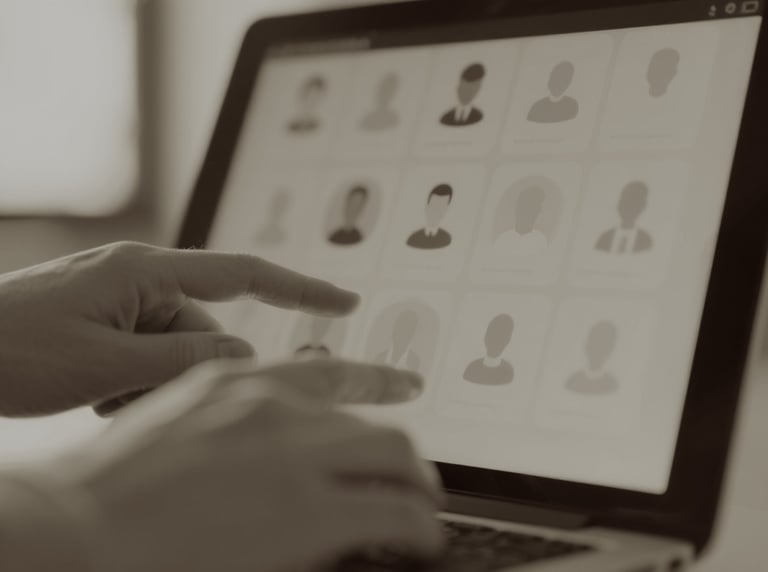Sock Puppets Go Pro
The Coalition of Cyber Investigators and guest contributor, Sagi Brody, discuss the operationalisation of digital personas in the public and private sectors.
Paul Wright, Neal Ysart & Sagi Brody
8/20/20254 min read


Sock Puppets Go Pro
Operationalising Digital Personas in the Public and Private Sector
Introduction: From Hobbyist Trick to Strategic Asset
What was once the realm of online trolling or basic open-source intelligence (OSINT) sleuthing has evolved. Today, the digital sock puppet—an artificial online persona—is no longer merely a side tactic. It’s a mission-critical asset used by law enforcement, corporate intelligence units, journalists, and cybersecurity researchers. The rise of professional tools like SockPuppet.io’s “Alias” platform and methodologies like Socket Theory has introduced structure, scalability, and legitimacy to covert digital identity work.
But how do these techniques differ between public and private sector operations? What are the trade-offs between cloud-based and standalone setups? And how can we ensure ethical and secure usage in a hyper-surveilled online world?
1. Sock Puppets in OSINT: A Quick Refresher
According to the SANS Institute, a sock puppet is a fictitious online identity used by investigators to mask their genuine identity while obtaining information, infiltrating communities, or monitoring digital activities.
This isn't about deception for its own sake—it's about operational security (OPSEC), legal compliance, and investigative integrity. Whether you are monitoring human trafficking rings or researching corporate espionage, sock puppets offer the necessary insulation to observe without becoming the observed.
2. From Covert Ops to Corporate Risk: Who Uses Sock Puppets and Why
Law Enforcement
Under frameworks like the UK’s RIPA (Regulation of Investigatory Powers Act), public agencies use sock puppets to perform limited, non-intrusive surveillance unless authorisation is escalated.
Corporate Intelligence
In private-sector investigations, sock puppets enable monitoring of competitors, fraud, or reputational threats—though legal oversight is often looser, which calls for robust internal policies.
Journalists and Non-Government Organisations (NGOs)
These actors must balance ethical investigation and platform violations. Sock puppets enable access to stories in sensitive communities while mitigating physical risks.
3. Socket Theory: A Framework for Structured Identity Operations
Socket Theory elevates sock puppetry from ad hoc tradecraft to a strategic methodology, emphasising:
Preplanning: Create personas in advance for realism.
Authenticity: Backstories, believable activity, and realistic profiles.
OPSEC: Virtual Private Network (VPNs), burner devices, unique emails, and clean metadata.
Adaptability: Adjust personas over time to remain credible and stay ahead of advanced detection methods.
Think of it as the "intelligence lifecycle" applied to digital persona management.


4. Enter SockPuppet.io: SockPuppets-as-a-Service
Platforms like Alias by SockPuppet.io remove the manual burden and compliance risk by offering:
Custom, managed identities
Virtual desktops and Android devices
Realistic network connectivity (not VPN)
Segmentation and attribution control
Regional and country-specific carrier-based SMS numbers
This is a purpose-built OSINT technology platform for teams that need to create and operate digital identities at scale. It combines managed attribution, operational auditability, and investigative workflow tools in one secure environment.
“Whether it’s a counter-fraud team or an investigative journalist, Alias by SockPuppet enables secure, scalable cover investigative and intel work with true managed attribution.” — Sagi Brody, CEO, SockPuppet.io
5. Cloud vs. Standalone Deployment: Which Is Right for You?
Takeaway: Cloud platforms like Alias deliver speed, standardisation, and scalability without sacrificing operational security, making them well-suited for corporate intelligence teams, NGOs, and even government operations that require cleared personnel and controlled environments. Standalone systems remain a strong choice for organisations with in-house technical capacity that demand fully self-managed infrastructure.
6. Best Practices for Cross-Sector Use
Whether you're in law enforcement, private intelligence, or ethical hacking, here are some best practices:
Always document the creation and activity of sock puppet accounts
Age and organic growth matter for some sock puppet investigations and intelligence work
Never reuse an identity across unrelated investigations
Use password managers, non-attributable infrastructure, and AI-audited personas to avoid common OPSEC failures
Never impersonate real individuals or bypass platform terms of service (ToS) with malicious intent
7. Ethical and Legal Considerations
Creating a sock puppet may violate the platform's ToS but is generally not illegal - provided it avoids harassment, fraud, or impersonation. However, you must adhere to your organisation’s internal ethics framework and relevant laws.
8. The Future: AI-Augmented Sock Puppets?
Expect future iterations to include:
Large Language Model (LLM) -augmented personas that can engage in chat convincingly
Language and cultural nuance detection for global ops
Synthetic voice/video footprints for phone-verified environments
Automated sock puppet-building engines
As OSINT evolves, so too must its personas.
Conclusion: Revolutionising Online Investigations—One Sock at a Time
Sock puppets are no longer a niche tool - they are foundational to modern OSINT. With frameworks like Socket Theory and platforms like Alias, the creation and deployment of covert digital identities have entered a new era: professional, scalable, and secure.
Whether you’re monitoring extremist groups, investigating financial crime, or mapping disinformation networks, remember you can’t trace what doesn’t exist.
“In a world where your IP address can betray you before you hit 'Enter', your sock puppet is your passport to secure truth.”
Authored by: The Coalition of Cyber Investigators
Paul Wright (United Kingdom) & Neal Ysart (Philippines), and with guest contributions from Sagi Brody, CEO of SockPuppet.io
©2025 The Coalition of Cyber Investigators. All rights reserved.
The Coalition of Cyber Investigators is a collaboration between
Paul Wright (United Kingdom) - Experienced Cybercrime, Intelligence (OSINT & HUMINT) and Digital Forensics Investigator;
Neal Ysart (Philippines) - Elite Investigator & Strategic Risk Advisor, Ex-Big 4 Forensic Leader; and
Lajos Antal (Hungary) is a highly experienced expert in cyberforensics, investigations, and cybercrime.
The Coalition unites leading experts to deliver cutting-edge research, OSINT, Investigations, & Cybercrime Advisory Services worldwide.
Our co-founders, Paul Wright and Neal Ysart, offer over 80 years of combined professional experience. Their careers span law enforcement, cyber investigations, open source intelligence, risk management, and strategic risk advisory roles across multiple continents.
They have been instrumental in setting formative legal precedents and stated cases in cybercrime investigations and contributing to the development of globally accepted guidance and standards for handling digital evidence.
Their leadership and expertise form the foundation of the Coalition’s commitment to excellence and ethical practice.
Alongside them, Lajos Antal, a founding member of our Boiler Room Investment Fraud Practice, brings deep expertise in cybercrime investigations, digital forensics, and cyber response, further strengthening our team’s capabilities and reach.
The Coalition of Cyber Investigators, with decades of hands-on experience in cyber investigations and OSINT, is uniquely positioned to support organisations facing complex or high-risk investigations. Our team’s expertise is not just theoretical - it’s built on years of real-world investigations, a deep understanding of the dynamic nature of digital intelligence, and a commitment to the highest evidential standards.